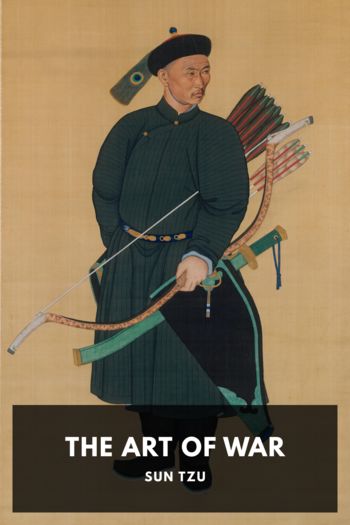The Art of War by Sun Tzu (elon musk reading list TXT) 📕

- Author: Sun Tzu
Book online «The Art of War by Sun Tzu (elon musk reading list TXT) 📕». Author Sun Tzu
The highest generalship, in Col. Henderson’s words, is “to compel the enemy to disperse his army, and then to concentrate superior force against each fraction in turn.” ↩
There is nothing about “defeating” anybody in this sentence, as Capt. Calthrop translates. What Sun Tzǔ evidently has in mind is that nice calculation of distances and that masterly employment of strategy which enable a general to divide his army for the purpose of a long and rapid march, and afterwards to effect a junction at precisely the right spot and the right hour in order to confront the enemy in overwhelming strength. Among many such successful junctions which military history records, one of the most dramatic and decisive was the appearance of Blücher just at the critical moment on the field of Waterloo. ↩
The Chinese of this last sentence is a little lacking in precision, but the mental picture we are required to draw is probably that of an army advancing towards a given rendezvous in separate columns, each of which has orders to be there on a fixed date. If the general allows the various detachments to proceed at haphazard, without precise instructions as to the time and place of meeting, the enemy will be able to annihilate the army in detail. Chang Yü’s note may be worth quoting here: “If we do not know the place where our opponents mean to concentrate or the day on which they will join battle, our unity will be forfeited through our preparations for defence, and the positions we hold will be insecure. Suddenly happening upon a powerful foe, we shall be brought to battle in a flurried condition, and no mutual support will be possible between wings, vanguard, or rear, especially if there is any great distance between the foremost and hindmost divisions of the army.” ↩
Capt. Calthrop omits 以吾度之, and his translation of the remainder is flabby and inaccurate. As Sun Tzǔ was in the service of the 吳 Wu State, it has been proposed to read 吳 instead of 吾—a wholly unnecessary tampering with the text. Yüeh coincided roughly with the present province of Chehkiang. Li Chʽüan very strangely takes 越 not as the proper name, but in the sense of 過 “to surpass.” No other commentator follows him. 勝敗 belongs to the class of expressions like 遠近 “distance,” 大小 “magnitude,” etc., to which the Chinese have to resort in order to express abstract ideas of degree. The Tʽu Shu, however, omits 敗. ↩
Alas for these brave words! The long feud between the two states ended in 473 BC with the total defeat of Wu by 勾踐 Kou Chien and its incorporation in Yüeh. This was doubtless long after Sun Tzǔ’s death. With his present assertion compare chapter IV: 勝可知而不可為, “Hence the saying: One may know how to conquer …” (which is the obviously mistaken reading of the Yü Lan here). Chang Yü is the only one to point out the seeming discrepancy, which he thus goes on to explain: “In the chapter on Tactical Dispositions it is said, ‘One may know how to conquer without being able to do it,’ whereas here we have the statement that ‘victory can be achieved.’ The explanation is, that in the former chapter, where the offensive and defensive are under discussion, it is said if the enemy is fully prepared, one cannot make certain of beating him. But the present passage refers particularly to the soldiers of Yüeh who, according to Sun Tzǔ’s calculations, will be kept in ignorance of the time and place of the impending struggle. That is why he says here that victory can be achieved.” ↩
Capt. Calthrop quite unwarrantably translates: “If the enemy be many in number, prevent him,” etc. ↩
This is the first of four similarly constructed sentences, all of which present decided difficulties. Chang Yü explains 知得失之計 as 知其計之得失. This is perhaps the best way of taking the words, though Chia Lin, referring 計 to ourselves and not the enemy, offers the alternative of 我得彼失之計皆先知也 “Know beforehand all plans conducive to our success and to the enemy’s failure.” ↩
Instead of 作, the Tʽung Tien, Yü Lan, and also Li Chʽüan’s text have 候, which the latter explains as “the observation of omens,” and Chia Lin simply as “watching and waiting.” 作 is defined by Tu Mu as 激作, and Chang Yü tells us that by noting the joy or anger shown by the enemy on being thus distrubed, we shall be able to conclude whether his policy is to lie low or the reverse. He instances the action of Chu-ko Liang, who sent the scornful present of a woman’s headdress to Ssǔ-ma I, in order to goad him out of his Fabian tactics. ↩
Two commentators, Li Chʽüan and Chang Yü, take 形之 in the sense of 示之 “put on specious appearances.” The former says: “You may either deceive the enemy by





Comments (0)